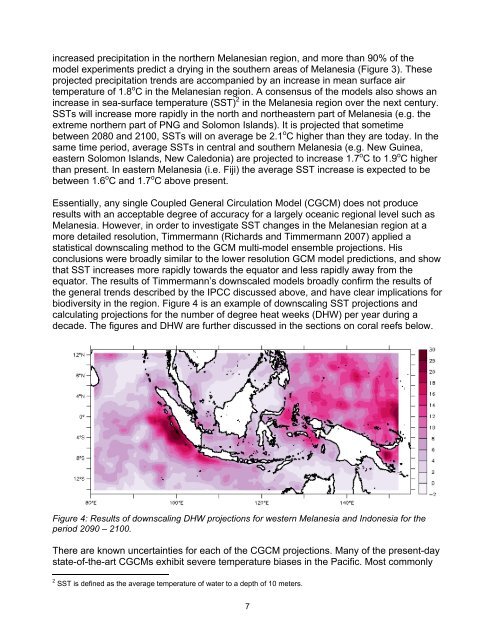What do we know? - Climate Adaptation Knowledge Exchange
What do we know? - Climate Adaptation Knowledge Exchange
What do we know? - Climate Adaptation Knowledge Exchange
- No tags were found...
You also want an ePaper? Increase the reach of your titles
YUMPU automatically turns print PDFs into web optimized ePapers that Google loves.
increased precipitation in the northern Melanesian region, and more than 90% of themodel experiments predict a drying in the southern areas of Melanesia (Figure 3). Theseprojected precipitation trends are accompanied by an increase in mean surface airtemperature of 1.8 o C in the Melanesian region. A consensus of the models also shows anincrease in sea-surface temperature (SST) 2 in the Melanesia region over the next century.SSTs will increase more rapidly in the north and northeastern part of Melanesia (e.g. theextreme northern part of PNG and Solomon Islands). It is projected that sometimebet<strong>we</strong>en 2080 and 2100, SSTs will on average be 2.1 o C higher than they are today. In thesame time period, average SSTs in central and southern Melanesia (e.g. New Guinea,eastern Solomon Islands, New Cale<strong>do</strong>nia) are projected to increase 1.7 o C to 1.9 o C higherthan present. In eastern Melanesia (i.e. Fiji) the average SST increase is expected to bebet<strong>we</strong>en 1.6 o C and 1.7 o C above present.Essentially, any single Coupled General Circulation Model (CGCM) <strong>do</strong>es not produceresults with an acceptable degree of accuracy for a largely oceanic regional level such asMelanesia. Ho<strong>we</strong>ver, in order to investigate SST changes in the Melanesian region at amore detailed resolution, Timmermann (Richards and Timmermann 2007) applied astatistical <strong>do</strong>wnscaling method to the GCM multi-model ensemble projections. Hisconclusions <strong>we</strong>re broadly similar to the lo<strong>we</strong>r resolution GCM model predictions, and showthat SST increases more rapidly towards the equator and less rapidly away from theequator. The results of Timmermann’s <strong>do</strong>wnscaled models broadly confirm the results ofthe general trends described by the IPCC discussed above, and have clear implications forbiodiversity in the region. Figure 4 is an example of <strong>do</strong>wnscaling SST projections andcalculating projections for the number of degree heat <strong>we</strong>eks (DHW) per year during adecade. The figures and DHW are further discussed in the sections on coral reefs below.Figure 4: Results of <strong>do</strong>wnscaling DHW projections for <strong>we</strong>stern Melanesia and In<strong>do</strong>nesia for theperiod 2090 – 2100.There are <strong>know</strong>n uncertainties for each of the CGCM projections. Many of the present-daystate-of-the-art CGCMs exhibit severe temperature biases in the Pacific. Most commonly2 SST is defined as the average temperature of water to a depth of 10 meters.7
















